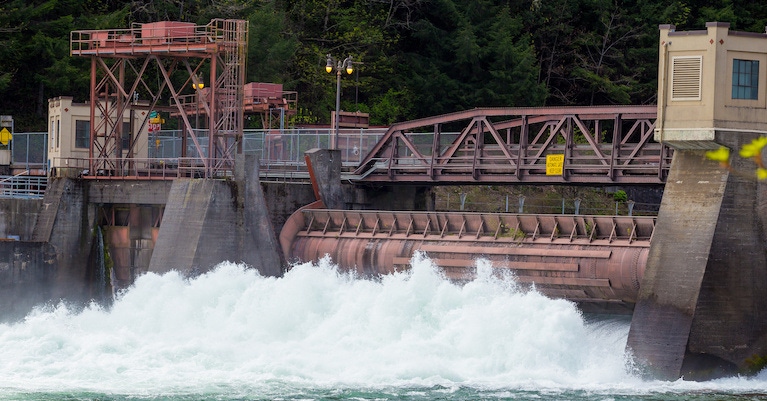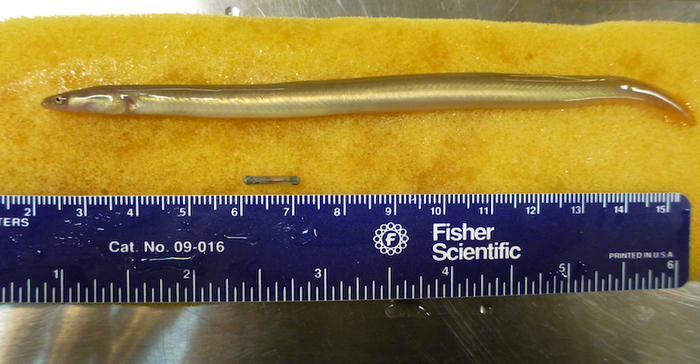Tagging small fish and young aquatic life is difficult—a tiny lithium battery is being used to power an innovative new system.
July 18, 2021

Just as Tesla and others are building some of the world’s largest lithium-ion batteries for grid storage and to enable renewable energy, researchers, and engineers at the National Renewable Energy Laboratory (NREL) are making some of the smallest batteries the world has ever seen. The lithium/carbon fluoride (Li/CFx) micro-battery created by NREL acts as the power source for an electronic tag to track young species of aquatic animals such as salmon, eel, and Pacific lamprey. This new information can be used to develop ways to protect young fish and support survival during downstream migration.
Opening the door
“Pacific lamprey are difficult to research and are, therefore, understudied. There’s a lot we still don’t know about them, and this tag opens the door to learning more about their behavior,” said Stephanie Liss, a PNNL Earth scientist in an NREL news release.
According to NREL “The high-energy battery lasts thirty days and powers an acoustic pulse the length of a football field every five seconds. The overall tag costs about the same as larger, commercially available acoustic tags originally developed by PNNL.” The injectable acoustic tag, called the Eel/Lamprey Acoustic Tag (ELAT), is about the size of a grain of rice and holds twice the energy of a AAA battery.
Chinook salmon in the Columbia River can be as small as two inches. Due to the size of existing acoustic tags, only fish larger than 3.7 inches could be tagged without impacting swimming ability. Now, with the ELAT, fish as small as 2.3 inches can be tagged. "The biggest hurdle was to balance size with performance,” said Daniel Deng, a Laboratory fellow and mechanical engineer who led the battery and tag development. “Smaller technology requires tradeoffs among competing parameters, such as battery life or acoustic strength,” he added. While there are commercially available micro batteries smaller than a human hair, they do not pack enough power for acoustic tags.

The Battery
The cylindrical primary micro-battery has an outer diameter of 1.8 mm and a length of 4.2 mm. It weighs just 20 mg and has a volume of 11 mm3. Immediately after assembly, the cell open-circuit voltage was above 3.3 V and after 30 days was it above 2.9 V. The energy density of the cell is greater than 300 Wh/L, and the specific energy is greater than 160 Wh/kg. After being stored at ambient conditions for 2 months, the capacity of the cell was greater than 1.4 mAh.Acceptable capacities were delivered at 0°C, 10°C, and 24°C, which covers the temperature range over which the fish tags need to operate.
“At PNNL, we are continuing to develop our technology with the goal of reducing the battery and tag size and, ultimately, the size of fish we are able to track,” said Deng. “This will help us better understand fish movement to get ahead of any potential conservation concerns, such as being listed as a threatened or endangered species.”
Better Information, Safer Hydroelectric Plants
NREL notes that “The potential applications extend far beyond eel, lamprey, and salmon. There is interest in using ELAT to track invasive species, such as Asian carp in the Mississippi River Basin or sea lamprey in the Great Lakes, in addition to better understanding other understudied species, such as smelt or shrimp.” With the worldwide populations of lamprey and eel declining, tracking their movement and survival is a first step toward conservation. “This new tag is exciting, because it means better information about previously understudied sizes and ages of fish, particularly ones of conservation concern and cultural significance,” said Liss.
The ELAT can help to provide more insight to support sustainable hydropower by following how fish and aquatic animals travel through and around hydroelectric power facilities. Using this information will allow the development of new technologies and improve the environmental performance of hydroelectric systems, while still providing clean, reliable power.
Kevin Clemens is a Senior Editor with Battery Technology.
About the Author(s)
You May Also Like





